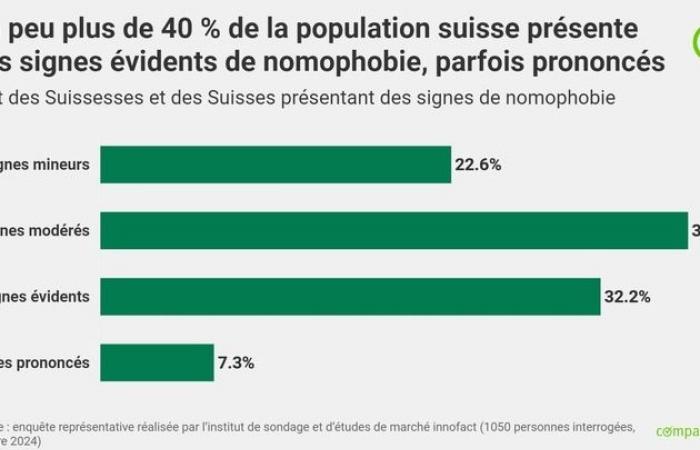12.11.2024 – 00:30
comparis.ch AG
A document
- 20241025_mm smartphonesucht_FR.pdf
PDF – 302 kB
Press release
Comparis representative survey on smartphone addiction
In Switzerland, 40% of adults show clear signs of smartphone addiction
A little over 40% of the Swiss population shows clear signs of smartphone addiction, sometimes pronounced. These are the results of a representative survey by comparis.ch. Frantic glances at your cell phone to not miss any notifications, feeling of stress when it is not within reach or the battery is empty, feeling of isolation in the absence of a smartphone: these signals are particularly common among young people and in French-speaking Switzerland. Gender, education level or income have no significant influence on smartphone addiction. “The smartphone allows you to access digital technology everywhere and all the time, to be reachable at any time and, increasingly, to carry out certain everyday actions such as paying, communicating or accessing your public transport subscription, a number An ever-increasing number of people let themselves be overcome by stress, or even panic, when it is not immediately at hand,” declares Jean-Claude Frick, Comparis Digital expert.
Zurich, November 12, 2024 – Smartphone addiction or nomophobia (from the English No-Mobile-Phone-Phobia) refers to pathological symptoms and feelings of anxiety or behavioral changes that are triggered when the smartphone is not not available (see box). It is very widespread in Switzerland. This is what emerges from a representative survey by comparis.ch, the online comparator. According to its results, more than 40% of those questioned show clear signs of nomophobia, sometimes marked, having obtained at least 30 points on a scale of 0 to 40. Only 23% of participants in the survey do have no difficulty doing without their cell phone.
“The smartphone allows you to access digital technology everywhere and all the time, to be reachable at any time and, increasingly, to carry out certain everyday actions such as paying, communicating or accessing your public transport subscription, a number An ever-increasing number of people allow themselves to be overcome by stress, or even panic, when it is not immediately within reach,” observes Jean-Claude Frick, Comparis Digital expert.
Young people are significantly more affected
Young people aged 16 to 35 are particularly affected by excessive smartphone use. In this age group, 54% clearly suffer from nomophobia, with symptoms sometimes pronounced. Only 14% can do without their cell phone without any problem. Among those over 55, on the other hand, 38% are impervious to smartphone addiction.
“Used for the most diverse tasks, the smartphone is the central digital gadget for young people. “Mobile phone addiction, combined with the fear of missing out, aggravates these symptoms in this part of the population,” says J.-C. Frick.
Romandie, region where smartphone dependence is most marked
There are also disparities at the level of linguistic regions. Smartphone dependence is significantly more marked in French-speaking Switzerland (where 47% of the population show at least obvious signs of nomophobia) than in German-speaking Switzerland (where this rate reaches 37%).
“In French-speaking Switzerland, the use of social networks, video streaming and gaming services is more marked than in German-speaking Switzerland. This is shown, for example, by the Digimonitor of REMP, the advertising media research and study company. Being at the forefront of digitalization could have a negative impact,” according to J.-C. Frick.
Easier to do without your cell phone in the countryside
There is also a city-country divide. In rural areas, 28% of people surveyed can do without their cell phone without any problem (compared to only 19% of city dwellers who answered the question). Conversely, 43% of city people are clearly affected by nomophobia, sometimes severely, compared to “only” 34% of the rural population.
For the Comparis expert, these data confirm a cliché: “In urban areas, smartphone use is higher due to professional and social demands. In rural areas, the need to be constantly reachable and the desire to do everything with your smartphone are less pronounced. Another factor: in the countryside, associations bring together a larger number of people than in the city. However, these associations play an important role in social life. We find ourselves there more often than on Facebook. »
Households with children are significantly more exposed to nomophobia
People living in households with three or more members are also more likely to be affected by nomophobia than those living alone or couples. Likewise, people living together with children are much more likely to show clear signs of a sometimes pronounced smartphone addiction than people without children. On the other hand, the level of education, income or gender have no significant influence on the tendency towards nomophobia.
“Within families, smartphone dependence is often higher, because parents and their children share the need to be reachable and to access information. In addition, during adolescence, young people rub off on their parents when it comes to their smartphone use. Thus, certain objects go from paper to digital, like the family calendar formerly hung on the wall,” explains J.-C. Frick. Hence his demand: “Schools must address the question of responsible smartphone use in even more depth and make it a compulsory subject. »
Checking the phone several times a day and feeling stressed when deprived
Survey participants were asked 10 questions about their smartphone use. Their responses provided a better understanding of their propensity to depend on their smartphone. Most often, they reported checking their device several times a day to make sure they hadn’t missed any messages. Next comes the mention of a feeling of stress in the absence of the smartphone. In third place among the most frequent responses comes the feeling of agitation at the very idea of not having your cell phone with you for at least a day.
One of the measures taken to prevent these situations is the possession of multiple cell phones. Logically, the Comparis survey therefore shows a significantly higher tendency towards misuse of their phone by people with two devices (46%, compared to 37% with a single device).
Digital detox and finding alternatives can help
Digital expert J.-C. Frick advises those affected to detoxify themselves from digital: “For example, you can limit your daily use to two hours and set fixed times for mobile phone use. » Likewise, it can be helpful to consciously put yourself in uncomfortable situations to gradually get used to deliberately resorting to other solutions (carrying cash, a credit card, a city map or wear a watch, for example). “But we have to take the disorder seriously. In severe cases, psychotherapy may be necessary,” explains J.-C. Frick.
What is nomophobia?
The term smartphone addiction or nomophobia (from the English No-Mobile-Phone-Phobia) refers to pathological dependence on mobile phones. It appeared in Great Britain in the late 2000s. A study by the British Postal Service showed that in Great Britain, almost half of mobile phone users suffered from smartphone addiction. Nomophobia can manifest itself through symptoms such as anxiety, physical reactions such as heart palpitations, sweating, or changes in behavior (such as not turning off your cell phone or carrying multiple devices with you). Nomophobia is not yet officially recognized.
Method
The representative survey was carried out by the survey and market research institute innofact on behalf of comparis.ch with a sample of 1,050 people from all regions of Switzerland. The survey took place in October 2024. Respondents answered 10 questions on a scale of 1 to 5 (1 – Strongly disagree, 2 – Mostly disagree, 3 – Neither agree nor disagree / Neutral, 4 – Somewhat agree, 5 – Completely agree). The number of points per question were accumulated and interpreted according to the following equivalences: Answers totaling 10 to 19 points: minor signs of nomophobia. Answers totaling 20 to 29 points: moderate signs of nomophobia. Answers totaling 30 to 39 points: clear signs of nomophobia.
Answers totaling 40 to 50 points: pronounced nomophobia.
The following questions were asked:
- I feel uncomfortable if I don’t have constant access to information through my smartphone.
- I get nervous when my smartphone battery is almost dead (
- I worry when I don’t have a mobile network or Internet connection (=2 bars).
- I often check my smartphone to make sure I haven’t missed any messages or calls (several times a day).
- I feel stressed when I don’t have my smartphone with me.
- I panic if I can’t use my smartphone immediately if I want to.
- I feel isolated when I can’t use my smartphone.
- I regularly interrupt (daily up to several times a week) while fully aware of other activities or conversations to look at my smartphone.
- I take my smartphone everywhere and use it or leave it so that I can see the screen, even in situations where this behavior might be inappropriate (e.g. in the bathroom, during meetings).
- The idea of being without my smartphone for a while (at least 1 day) worries me.
For more information:
Jean-Claude Frick Expert Numérique chez Comparis Téléphone: 044 360 53 91 E-Mail: [email protected] comparis.ch
About comparis.ch
With more than 80 million visits per year, comparis.ch is one of the most visited websites in Switzerland. The company compares the prices and services of health funds, insurance companies, banks and telecom operators. It also presents the largest online offering in Switzerland for automobiles and real estate. With its detailed comparisons and in-depth analyses, it contributes to more transparency in the market. comparis.ch thus strengthens the expertise of consumers in decision-making. The company was founded in 1996 by economist Richard Eisler. This is a private company. Even today, Comparis is majority owned by its founder. No other company or the State holds any stake in Comparis.






